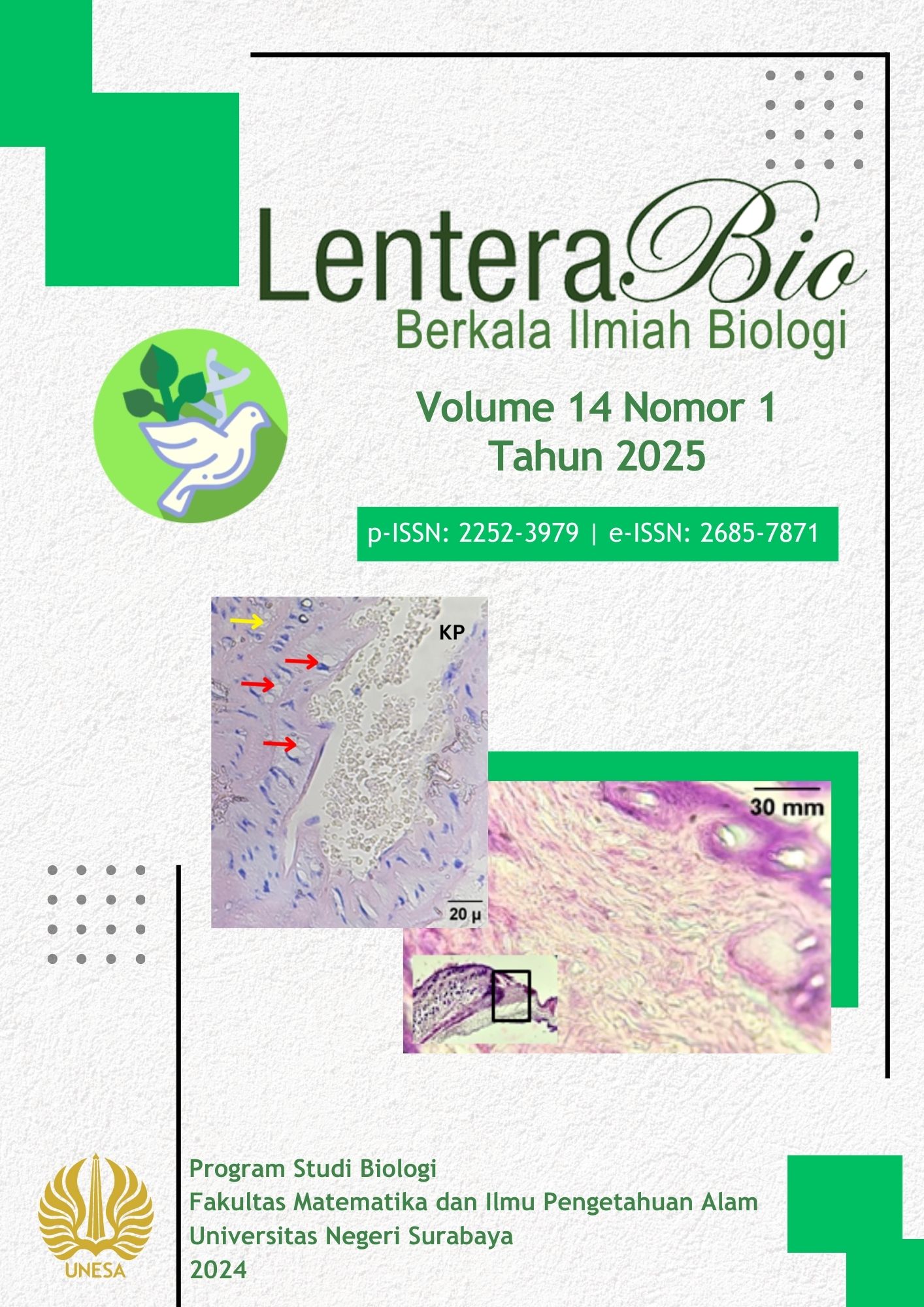Local Knowledge of the Sugihwaras Village Community of the Larung Offerings Tradition on Mount Kelud, Kediri Regency
DOI:
https://doi.org/10.26740/lenterabio.v14n1.p119-129Keywords:
biodiversity, conservation, culture, ethnobotany, perceptionAbstract
Larung Offerings Kelud tradition is a traditional ceremony that requires plants. The relationship between plants and humans is studied in ethnobotany which has the potential to reveal local knowledge about biological resource diversity, conservation and culture. Therefore, this study aims to analyze the local knowledge of the community and the importance of plants used in the tradition of Larung Offerings Kelud. This study used a descriptive method with observation and interviews of five key informants as well as questionnaires to 30 participants. Participants were grouped by age, namely young (17-30), adult (31-44), middle-aged (45-60) and old (> 60 years). Community perception data were analyzed using a Guttman scale while the importance value used the fidelity level formula. The results showed that the perceptions people of aged 17-30 and 31-44 were good and low on the meaning of offerings and plants. Age 45-60 and >60 years old are very good and classified as good on the meaning of offerings and the meaning of offering plants. The highest importance of plants were rose (96.6%), cantil, jasmine and ylang (93.3%), coconut (90%), plantain (86.6%) and pandan wangi 83.3%; these plants were special plants that must be present in the tradition of Larung Offerings Kelud. The introduction of traditions along with plant species and their meanings needs to be carried out especially for the younger generation so that traditional knowledge is not lost. Research on local knowledge should be well documented because it is important information and plant diversity and culture in Indonesia remain sustainable.
References
Ahmad T, 2020. Inventory and Ethnobotanical Study of Aquatic Plants in the Aquatic Park of Eka Karya Botanical Garden Bali, Journal of Biology and Biology Education 9 (1): 1-10.
Backer AC and Van Den Brink BCR, 1965. Flora of Java (Spermatophytes Only). The Netherlands: N.V.PNoordhoff-Groningen.
Bambang D, 2016. 5 Irrefutable Myths of Natural Disasters. Surabaya: Nida Dwi Karya.
Berk LE, 2017. Development Through the Lifespan. 7th edition. Pearson, USA.
Cunningham AB, 2014. Applied Ethnobotany: People, Wild Plant Use and Conservation. Routledge: London and Sterling VA.
Geng Y, Hu G, Ranjitkar S, Shi Y, Zhang Y and Wang Y, 2017. The Implications of ritual practices and ritual plant uses on nature conservation: A case study among the Naxi in Yunnan Province, Southwest China. Journal of Ethnobiology and Ethnomedicine 13(1): 58.
Hidayah DR, Wisanti W and Kristinawati PE, 2021. Local Knowledge of Wonosalam Jombang Community about Ken-Duren Ceremony. Journal of LenteraBio 10(3): 309-318.
Indah NK, Indriyani S, Arumingtyas EL and Azrianingsih R, 2021. Conservation of Local Salak in East Java, Indonesia: Community Knowledge and Appreciation. Biodiversity Journal of Biodiversity 22(1): 416-423.
Kartiwa S and Wahyono M, 1992. The Relationship Between Plants and Humans in Traditional Ceremonies in Indonesia. In Proceedings of Ethnobotany Seminar and National Workshop on Ethnobotany. Bogor.
Kurnia I, 2018. Revealing the Values of Kediri Local Wisdom as an Effort to Preserve the Culture of the Indonesian Nation. Journal of Elementary School Teacher Education 1(1): 51-63.
Leksikowati SS, Oktaviani I, Ariyanti Y, Akhmad AD and Rahayu Y, 2020. Ethnobotany of Medicinal Plants of Lampung Tribe Local Communities in West Lampung Regency. Journal of Biologica Samudra 2(1): 35-53.
Mohanty N, Das PK and Panda T, 2011. Use of Plant Diversity in Household and Rituals by Tribal People of Dhenkanal District, Odisha, India. Journal of Applied Pharmaceutical Science 1(4): 79-82.
Musa MI, 2015. The Impact of Globalization on the Life of the Indonesian Nation. Journal of Basic Enchantment 3(3): 1-4.
Pramita NH, Indriyani S and Hakim L, 2013. Ethnobotany of Kasada Ceremony of Tengger People, in Ngadas Village, Poncokusumo District, Malang Regency. Journal of Indonesian Tourism and Development Studies 1(2): 52-61.
Purwanti, Miswan and Ramadhanil P, 2017. "Ethnobotanical Study on the Customary Ritual Process of the Saluan Tribe Community in Pasokan Village, Tojo Una-Una Regency". Biocelebes 11(1): 46-60.
Purwanto Y, 1999. The Role and Opportunities of Contemporary Ethnobotany in Indonesia in Supporting Biodiversity Conservation and Development Efforts. Proceedings of the Seminar on Research Results in the Field of Life Sciences of the Inter-University Center for Life Sciences. Bandung: IPB.
Ratnani DAS, Junitha IK, Kriswiyanti E and Dhana IN, 2021. The Ethnobotany of Ngusaba Ceremonial Plant Utilization by Tenganan Pegringsingan Community in Karangasem, Bali, Indonesia. Biodiversity Journal of Biological Diversity 22(4): 2078-2087.
Rusmawati R and Suharti S, 2016. Tradition of Larungan Buceng Agung in Telaga Ngebel as a Means of Attracting Tourists. Journal of Humanities Research UNY 21(2): 123241.
Sartini, 2004. Exploring the Local Wisdom of the Archipelago A Philosophical Study. Journal of Philosophy 37(2): 111-120.
Steenis CV and Van GJ, 2013. Flora for Schools in Indonesia. PT Balai Pustaka.
Suaria N, Sulistiawati NPA and Astiari NKA, 2020. Dentification and Charateristics of Genetic Resources of Orange Plants I District Bangli-Bali. WARDS 2020: Proceedings of the 3rd Warmadewa Research and Development Seminar, Dec. 21, European Alliance for Innovation, pp: 18-23.
Tantowi NPX, Sukenti K and Mulyaningsih T, 2022. Ethnobotanical Study of Tumpek Wariga Tradition in Hindu Community of Jagaraga Village, West Lombok Regency. Journal of Tropical Biology 22(3): 746-756.
Witjoro A and Sulisetijono SF, 2016. Utilization of Medicinal Plants in Kayukebek Village, Tutur District, Pasuruan Regency. Journal of Natural B 3(4): 304.
Yuliamalia L, 2019. Larung Saji Tradition as an Effort to Maintain Ecosystem in Telaga Ngebel Ponorogo Tourism. Journal of History and Learning 9(2): 135-145.
Downloads
Published
How to Cite
Issue
Section
License
Copyright (c) 2025 LenteraBio : Berkala Ilmiah Biologi

This work is licensed under a Creative Commons Attribution-NonCommercial 4.0 International License.
Hak Cipta (c) LenteraBio: Berkala Ilmiah Biologi
Karya ini dilisensikan di bawah Lisensi Internasional Creative Commons Attribution-NonCommercial 4.0.
Pemberitahuan Hak Cipta.
Hak cipta dari artikel yang diterima untuk diterbitkan akan diberikan kepada jurnal sebagai penerbit jurnal. Hak cipta yang dimaksud meliputi hak untuk menerbitkan artikel dalam berbagai bentuk (termasuk cetak ulang). Jurnal mempertahankan hak penerbitan atas artikel yang diterbitkan.
 Abstract views: 203
,
Abstract views: 203
, PDF Downloads: 167
PDF Downloads: 167











